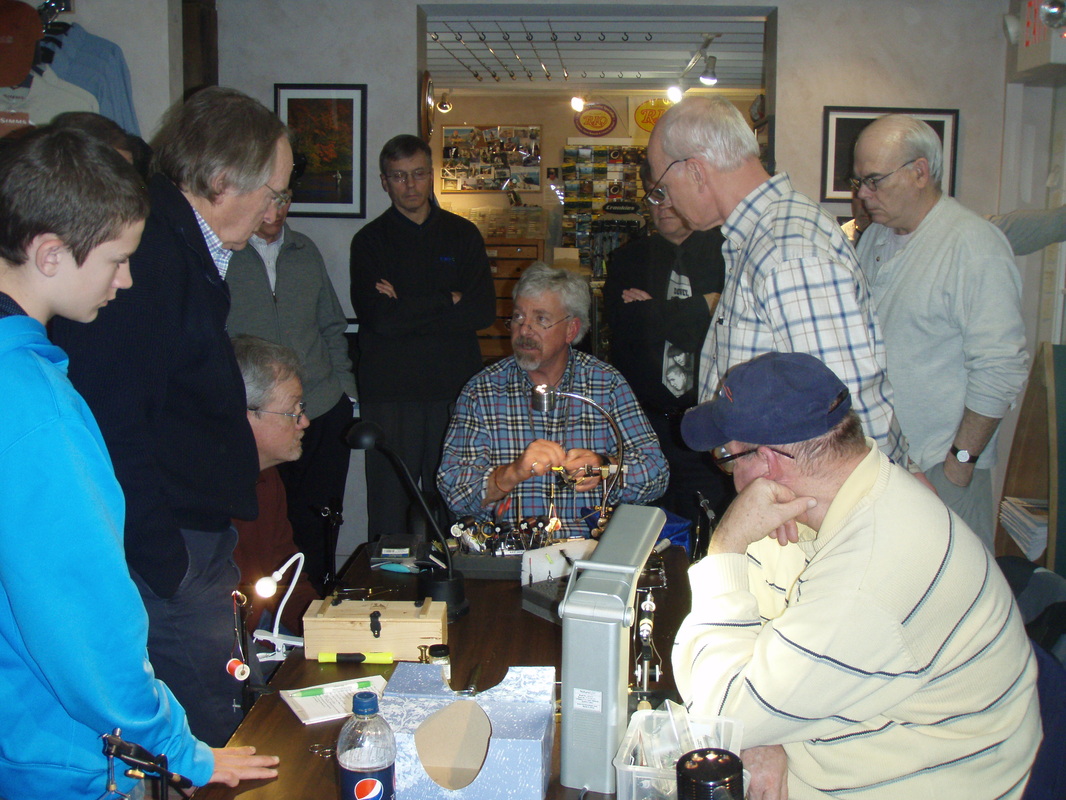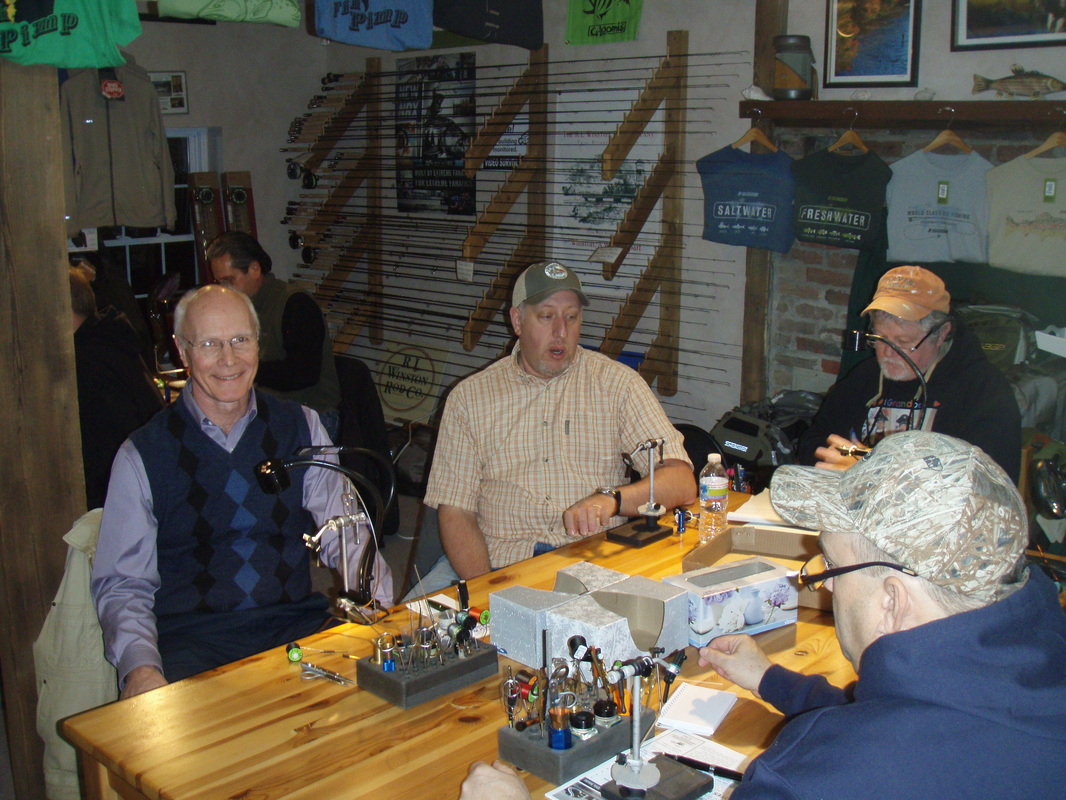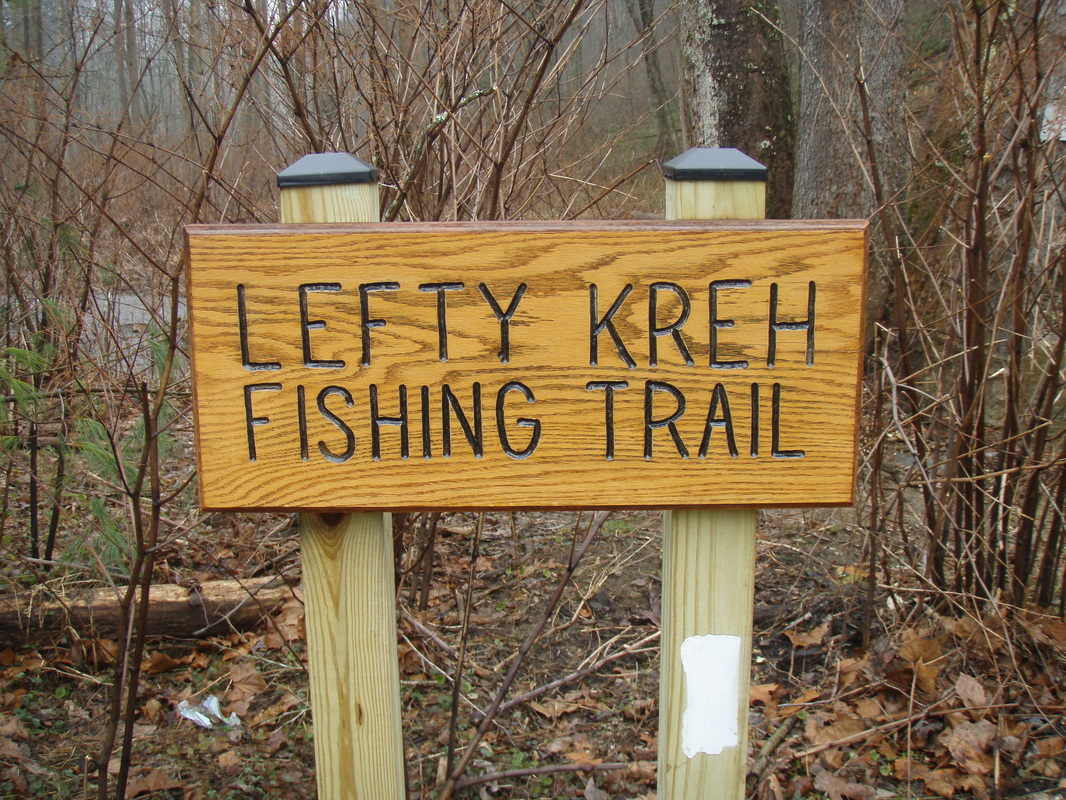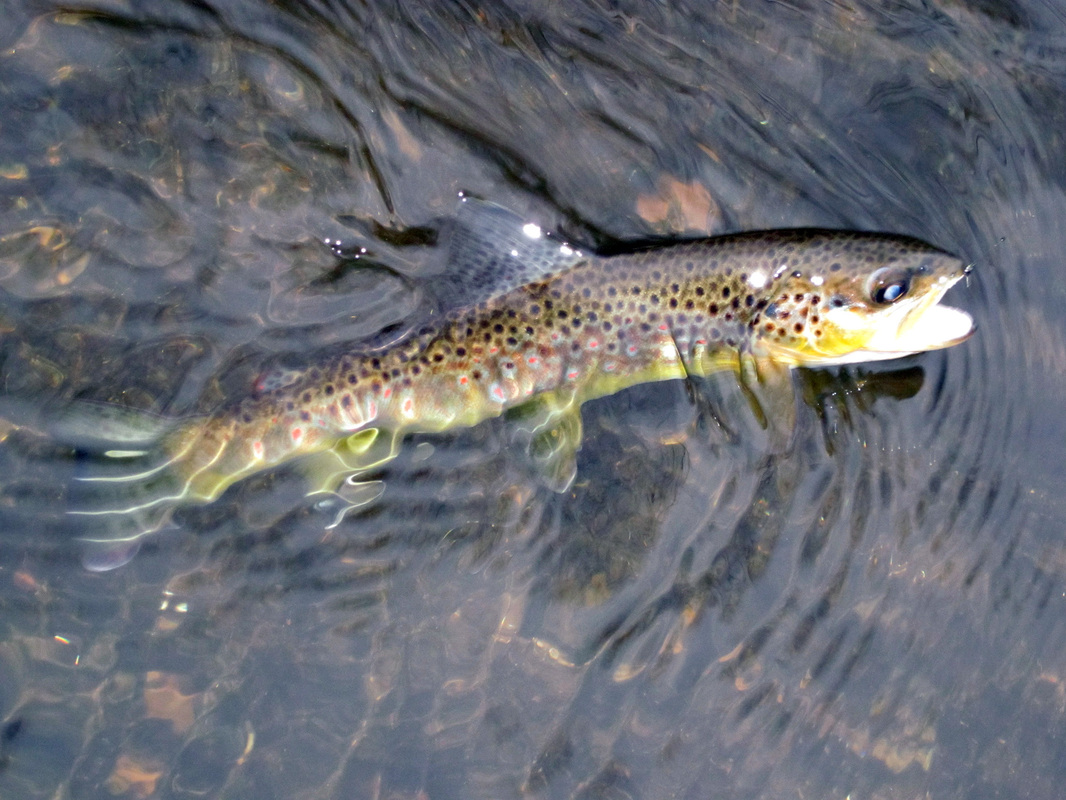|
Emerson showed us this knot last week after the advanced freshwater fly tying class. This is a way cool loop knot that is simple to tie and super strong. Sometimes called the "Baja" knot because of the popularity with Roosterfish guides in Baja. I will use this knot for sure this year, thanks Emerson for sharing it with us. BTY the ending of this you tube is CLASSIC!
Well, we just finished week #2 of our fly tying classes. A quick check of the "homework" from all three classes tells us everybody is progressing great. Here are a few samples of homework from the advanced class. We started the Tuesday class off with one of the all time classics, the Clouser Minnow. Shad fishing was the theme of the evening and both patterns we did were tied in the classic red / yellow, or red / white color scheme. Perfect for American or Hickory Shad. Because we were tying these patterns "Micro" size Terry opted to use Calf Tail instead of more popular Buck Tail. After everyone in the class finished the Clouser we tied a standard Calf Tail streamer suitable for Shad fishing. The class was fun and informative. Remember guys, the techniques you learned in this class hold true for bigger flies as well as different materials. Ostrich was the theme for the Wednesday class. We introduced the class to two patterns that use Ostrich hurl as part of the recipe. The first fly is a very important, yet often overlooked pattern, the Crane Fly Larva. We used John Barr's pattern as the model for this one. The second fly was the Ray Charles. A Scud pattern that is so effective it is said a blind trout will eat it, hence the name. Both great patterns and we hope you had as much fun tying them as we did teaching them. The saltwater class tied what is possibly the best, wide profile bait fish pattern ever invented, Lefty"s Deceiver. Everybody in the class "nailed it" according to Terry. A box full of these in a few colors and sizes will go a LONG way in our local and not so local saltwater fishing. We did have an epoxy issue. Some impromptu testing on our part reviled it was the resin that there was an issue with. I think it looks kinda cool. I cant wait to see what next week will bring. Till then...
Tight lines For any of you fishing or boating during the cold weather months this might be of interest to you. Check out the link below for a new regulation form the Pennsylvania Fish and Boat Commission.
http://www.fishandboat.com/boatcrs/pfd/faq-pfd-cold.htm We started the winter fly tying classes last week and they went great! Tuesday night is the beginner class. This class is as full as we have ever seen with a total of 17 people attending. We started class with the venerable Green Weenie. A staple pattern in the White Clay and a perfect pattern to start beginning tiers off with. The second fly of the night was the Wholly Bugger. Terry used the verigated chenille for the sample pattern. It is easier to see the two tone chenille when it is being wrapped around the hook shank, and this is why Terry used it. After seeing the end result I think we may have stumbled onto something. It was great to see all of the guys in class learning new techniques. We are proud to say that every fly that was tied in class is "fishable" and everybody did a great job. I am really excited to see some of the homework next Tuesday night. Here are a few more pictures from the Tuesday night class. Night two, the Wednesday night class, is the advanced fresh water class. This class has a core group of guys that return every year. This is a great thing for the shop, because it forces us to come up with new and innovative patterns to teach in class. We say "teach" some might say "torment" but it is all in the name fun. The best way to strengthen your skill set is to tie flies and patterns you might not normally attempt. We jumped right in with a cased Caddis pattern. Definitely an advanced pattern with a section of the fly tied with a dubbing loop consisting of Pheasant tail fibers. A mess for sure while tying the fly, but if done correctly it looks way cool after it is trimmed to shape. The second fly of the night was a "gimme" compared to the first one, the Teeny Nymph. With only 3 materials including the hook and thread this is a "box filler" as you can crank out a bunch of these in short order. Its ease of tying is only matched by its effectiveness in the water. A great night was had by all and once again the homework results will be interesting to see. I am sure everyone will do a great job. Here are a few pictures from the Wednesday night class. The third night of class is the Thursday night Saltwater class. Staple patterns were the theme of the week with the two flies being the Clouser minnow and the Half and Half variation. Do you think it is a coincidence that we start the saltwater tying class with arguably the most effective pattern ever? This is usually the smallest class, which is a shame because there will be a ton of knowledge gained by the attendees after the 6 weeks. The guys did great. The Stripers and Blues are going to be in real trouble this spring when these patterns hit the water. Here are the pictures from the Thursday night class. The tying classes are a great time for both the teachers and the attendees. If you think you may be interested in taking a class click here for more information. Till next week...
Tight Lines This came across the wire the other day. It is too good not to share! Enjoy. Well It is good to be bringing you the first fishing report of 2013. We hope all of you had a great holiday season and that Santa brought all of the things you asked for. Now with all of the hoopla of the holidays in the rear view mirror it is time to get out and hit the streams for some winter Trout fishing. As many of you have heard me say, winter time can be some of very best fishing of the year. Cold weather means less people and lightened angling pressure. You can always dress for the cold and with a few modifications in your tactics you can have some very productive days in the dead of winter. (to read a few tips on dressing for the weather click here) Grab your midge box filled with #18 thru #24 Zebra Midges, Throw in a few CDC Puffs or Griffith Gnats for action on top and you are set. Mid day hours, 10:00 am till 4:00 pm, rule this time of year with the most productive time being the late afternoon when the temperature reaches its peak. Usually around 3:00. Get in the mental mindset of small flies, light tippet (6 or 7x) and MANY drifts and you will be on your way. Even after several hours of hard fishing 3 fish in the dead of winter is a good day, and it is not uncommon to catch the "skunk" as I did on Sunday. All of that being said any time on the river is a good time, so get out there and give it a go. I think you will be glad you did. Terry, Rick and I headed to the Gunpowder this past Sunday. When we arrived at the steel bridge at Macemore We were greeted with an overly full parking lot, lots of fog, and 44 degree water temps. It was nice to see that a fishing trail had been dedicated to Lefty. There was a nice bronze plaque that I failed to get a picture of. If you are ever in the area you should check it out. It is a pretty cool read. Terry and I went down stream and Rick opted to fish above the steel bridge. It was obvious the nice weather had everybody thinking the same thing. A quick look at the banks and the amount of footprints let us know we were playing "second fiddle" as the stretch had been fished hard the last few days and in the morning before we got there. I started with my favorite winter Gunpowder rig, a #16 green Copper John and a #20 black Zebra midge under an indicator. Throughout the day that evolved to a dry and dropper set up consisting of a #14 Simulator with a #22 KF flasher AND a #18 bead head PT. Having no luck with ether set up I switched to a Zoo Cougar for the last half hour with similar results. Terry had a little better luck with two hook ups. I believe both came on a Zebra midge under a Simulator. Terry said both fish were typical wild Gunpowder browns in the 8 to 10" range. Rick had the hot hand of the day with 5 fish coming to hand. Rick was letting his nymph rig swing all the way below him and all the fish he got hit the fly on the dangle. My hat is off to you Rick, I don't think I would have figured that one out. I must say it was a nice day to be out even without a fish landed for me. Any day on the river is a good day, especially when you can spend it with good friends.
The White Clay still holds a large number of fish. the nice weather this past week brought out the anglers. Water temps in the low 40's have the fish down and finding active fish is a must. If you see fish that look like they are stuck to the bottom with Velcro, move on. Look for fish that are off the bottom and moving up and down within the water column. These are the active, feeding fish we are looking for and these are the ones you want to fish to. Red has always been a go to color on the Clay with a preferred rig being a #16 red Copper John and a #22 red Zebra midge. Griffiths Gnats, or small dark bodied Midge imitations should work if fish are rising. Sculpin imitations or dark Buggers should bring a few fish to hand as well. The East Branch of the Brandywine as well as the West Branch of the Octoraro should fish well during warmer periods of the day. Don't forget these great local rivers. Schoolie Bass can be found at the local beaches and we had a report of Puppy Drum off the surf last week. Plenty of fishing opportunities are available to us during the winter months. Dress warm and get out there. Tight lines... Jim is a long time customer of the shop and has been a student in many of our tying classes throughout the years. Jim has been working on a Tuna fly pattern during the last few months. He stopped in the shop a few weeks ago with the first prototypes on his new fly. After a nice conversation about the fly and a few suggestions from us including a minor material change Jim told us he was going to enter the fly in the annual competition held by the Saltwater Fly Anglers of Delaware. We we are proud to say Jim took top honors with the fly he named the "JS Tuna Fly". All of us here at A Marblehead Flyfisher would like to congratulate Jim on a great job! For more information on the Saltwater Fly Anglers of Delaware click here. This is a Great club that deserves all of our support.
As the White Clay is now full of fish due to the club’s “Holiday Stocking” many of our thoughts turn to winter time fishing. The winter months can be some of the best fishing of the year. Due to the weather conditions we face during December, January and February they can be some of the toughest times to be out there. I would like to give some of our thoughts and insights as to how we dress for the tough months in hopes that you can extend your time on the water. Hypothermia is a serious consideration during this time and we want to be sure you are protected from the elements. Let’s start with our feet and work our way up.
Layering is the key to staying warm in the winter and our feet are no different. We generally like to start off with a liner sock of some type. Polypropylene gets the nod here as it is the best material to wick sweat away from your feet, the key to keeping your feet warm. From here the temperature will determine the next layer for me. In mild times say 30 degrees and up a simple wading sock works for me. In extreme temps, 30 and below I will usually wear a liner sock, a cotton type crew sock and then a heavy wading sock like the Simms Extreme wading sock. This combo keeps my feet warm in the coldest of days. Play around with your sock combo until you find a system that works for you. One item of note; as you add layers of socks on your feet those wading boots that feel great in April and May might be too tight in January. Tight boots equal cold feet period! A sizeable investment for sure, but a pair of boots a size or two bigger can be a godsend. Next would be the body layers. Again the conditions will determine how many or how few layers you need. Anything that touches your skin needs to have some wicking properties. We all sweat and the key to staying warm is to get that perspiration away from your body. One of the newer products on the market that gets the nod from me is Merino Wool. A Merino wool base layer will go a long way to keeping your body temperature regulated. My next layer would be some sort of fleece. Simms and Redington both have several different types of fleece in different weights to fit your needs. From light weight shirts and pants to heavy weight crew tops and extremely warm one piece “jumpsuits.”There is a product for everybody. To this I will usually add a Windstopper jacket of sorts and this combo seems to keep me warm on most excursions. On those extreme days I might add a mid weight or heavy weight layer of fleece on top of a light weight layer. The key is to have interchangeability in your system so you can adapt to the changing climate. Hands head and face. We all have heard the saying that you loose most of your body heat through your head. If that is the case lets cover it with a quality hat to prevent that from happening. “Beanie” type hats are fine in mild temperatures; I wear them all the time. I particularly like the visor type of hats from Simms and Loomis. The next step up would be the Extreme hat from Simms. We call it the “Elmer Fudd” at the shop for obvious reasons. Insulated to the max with ear flaps to boot if any hat is going to keep you warm this is the one. Not the most asthetically pleasing hat, but when it is 10 degrees keeping warm is the priority. Remember this isn’t a fashion show. To this I might add one of the polar Buffs. This insulated, fleece lined “collar” is designed to keep your neck warm, and can be worn on your face like a half mask. Both are a priority in order to keep warm. Last but not least are gloves. I like the fingerless models so I can have some dexterity when tying knots. Actually I believe it is impossible to tie knots with gloves on. If you are prone to cold fingers one of the fold over mitts may be better. These have a fingerless glove inside and a mitten flap that will fold over the entire thing. A great idea, but fishing with mittens on will take a little getting use to. In the winter time try to touch as little water as possible. Once you get your hands cold in February it is tough to get warm them back up without leaving the river. Some of those hand warmers stuffed in your top wader pocket and help with this. During the winter season, especially during bitter times I try to always fish with a partner. Safety in numbers goes a long way when it is 20 degrees out. I try not to stand in the water for extended periods of time. If you feel your self getting cold get out and go for a little walk. The foot traffic on the rivers is usually light this time of year. Many times I can walk for ten or 15 minutes to get warmed back up and return to the same spot. Also I always carry a “fall in bag”. If I do happen to take a spill (and believe me I do) I have a warm, dry set of clothes waiting for me at the truck. If you do go in the water this time of year IMMEDITEALY get out and head to the truck. As I said earlier Hypothermia is no joke and needs to be taken seriously. Get out, get dry and go home. The fish will be there tomorrow. Hopefully these tips will keep you warm and out on the river this winter. Have a safe and fun filled winter season. We hope you catch a ton of fish. Tight lines… Korkers KGB Boot incorporates the comfort and technical functionality previously found in Korkers wading boots, while enhancing stability and durability. Extra durable rubber, mesh and laces were added along with a TPU cage and Vibram Idro Grip outsoles, significantly raising the performance of this guide-level wading boot. Here is the video from the Korkers web site about the new KGB boot. All of the KGB boots we have in stock come with 2 sets of soles, the Vibram Idro Grip outsoles in a studded and non studded version. The Aluma Trax sole is another new product from Korkers we are really excited about. A sole with maleable aluminum bars made to cut through slime. These soles grab rocky river bottoms extremely well. Wear and tear will only improve performance by increasing surface area. Inspired by Korkers aluminum bar overshoe cleats from years past, this outsole option provides sure footed traction in challenging terrain. Korkers motto is "Adaptable Traction Footwear". Here at A Marblehead Flyfisher we could not agree more. To see more of the great Korkers products click here. To See the full line of Korkers wading boots and all of the accessory outsoles please feel free to stop buy the shop. We look forward to seeing you.
|
Archives
January 2019
Fishing
Keep up to date on all things flyfishing. Categories
All
|
|






























 RSS Feed
RSS Feed
